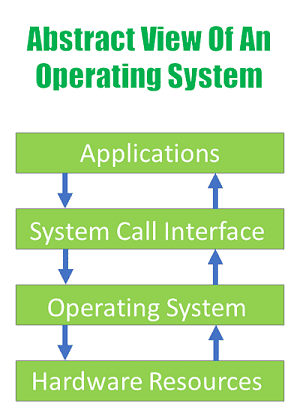An operating system (OS) is software that manages the resources of a computer system and provides a platform for other software applications to run on.
The abstract view of an operating system provides a high-level representation of its components and functionalities, hiding the implementation details from users and application programs.
Abstract View of OS
The abstract view of an Operating System is a conceptual representation of its components and their functions. It is a simplified model that helps us understand how the Operating System works at a high level.

Abstract view of an operating system’s components
- Applications: These are programs that users interact with directly, such as word processors, web browsers, and media players. They rely on the services provided by the operating system to perform their functions.
- System Call Interface: It is the interface between the application and the operating system. It provides a set of functions that applications can use to request services from the operating system, such as creating a new file, reading from a network socket, or allocating memory.
- Operating System: It is the layer that manages the resources of the computer and provides services to the applications. It is responsible for tasks such as process scheduling, memory management, device drivers, and security.
- Hardware resources: These are the physical components of a computer, such as the CPU, memory, storage devices, and input/output devices. The operating system manages these resources to ensure that they are used efficiently and effectively.
In this model, the Applications interact with the System Call Interface to request services from the Operating System, which in turn manages the Hardware Resources to provide those services.